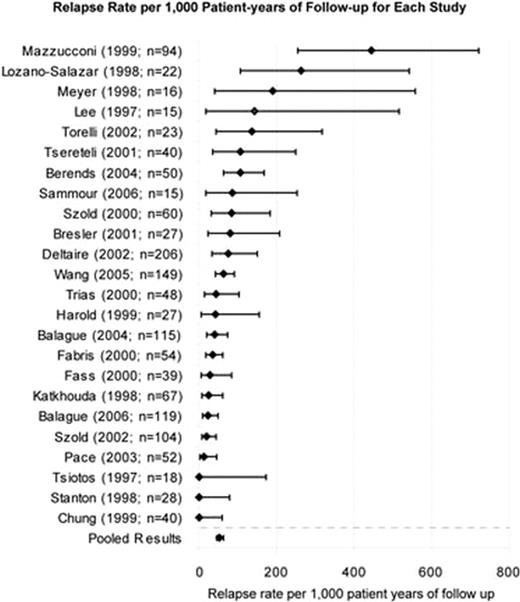Abstract
Splenectomy serves as a common therapy in treating adults with chronic ITP. Laparoscopic splenectomy was introduced in 1991 with the goal of reducing complication rates. This study was designed to estimate both the initial surgical non-response rate and the long-term relapse rate of splenectomy in the post-laparoscopic era. A systematic literature review was conducted by searching PubMed for articles published between January 1, 1991 and October 3, 2006. Selection criteria included: chronic ITP, study enrollment in 1990 or later, ≥12 months of follow-up, ≥15 patients with ITP, ≥75% of patients at least 14 years of age, not HIV positive, and not undergoing a second splenectomy. Response rates for surgery were collected according to an author-defined platelet response criterion (platelet counts <50x109/L or <30x109/L in 75% of studies). Relapse rates post-splenectomy (using the same platelet response criteria) were also collected. A meta-analysis was conducted to estimate a pooled surgical non-response rate as well as a pooled relapse rate in responders by weighting the study-specific estimates by the inverse of their variances, using Stata 9™. The pooled relapse rate was converted to a probability using the exponential formula, e(-rate x time). We identified 161 articles for detailed review. Of these, 24 met our inclusion criteria, all of which were observational studies. These studies represent 1,138 laparoscopic splenectomies (66 or 5.8% were converted to open splenectomy during surgery), and 317 open or undefined splenectomies. The average surgical non-response rate across 21 studies reporting data was 12.2% (95% CI: 10.3–14.3%). The average long-term relapse rate per person year across all studies was 53 per 1,000 patient years (95% CI: 45.0–62.0%). This corresponds to a 5% per year failure rate, or 32% failure rate after 5 years, for all patients initiating surgery. Initial non-response rate to planned splenectomy is 12% in adults with ITP. For patients undergoing laparoscopic splenectomy, 6% required conversion to open splenectomy. The 5 year relapse rate post-splenectomy is 32%. Splenectomy, although the current standard of care, is not always initially successful and does not provide a durable response in all patients. The benefits and risks of splenectomy must be weighed in light of newer options of therapy currently available.
Relapse Rate per 1,000 Patient-years of Follow-up for Each Study
Relapse Rate per 1,000 Patient-years of Follow-up for Each Study
Author notes
Disclosure:Employment: RD: Amgen. Consultancy: JM, MD: Amgen. Ownership Interests:; RD: Amgen. Research Funding: JM, MD, CK: Amgen. Honoraria Information: JM: Amgen. Membership Information: JM.


This feature is available to Subscribers Only
Sign In or Create an Account Close Modal